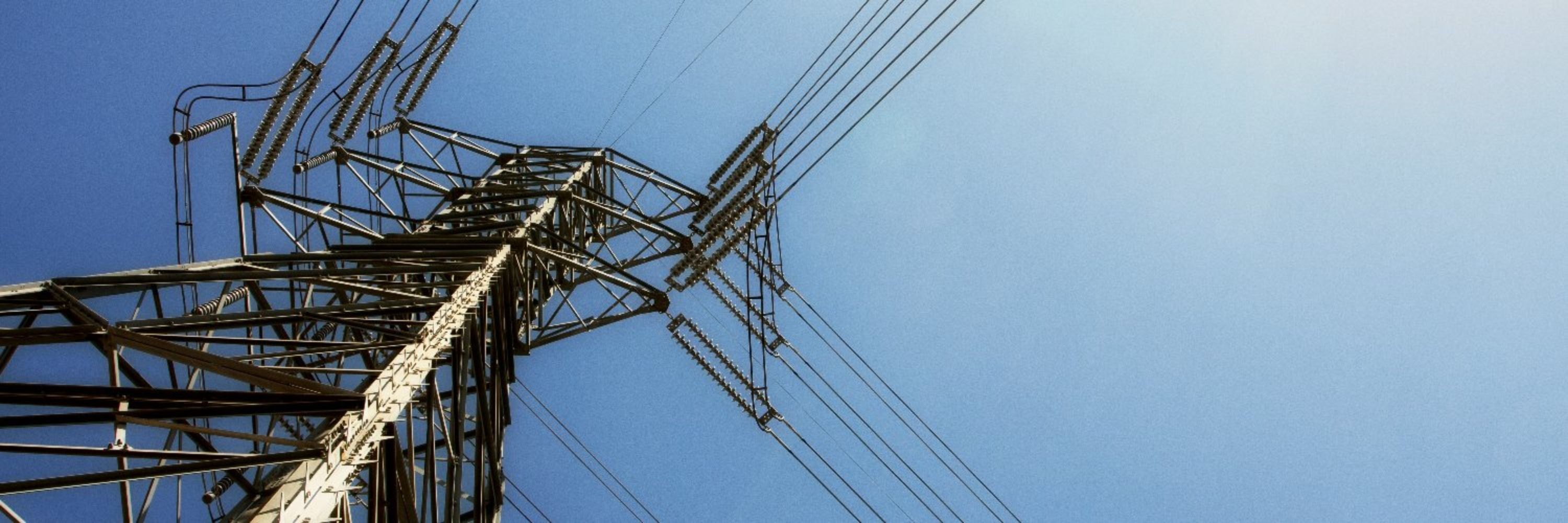
TransitionZero
@transitionzero.org
⚡️ A non-profit climate tech startup based in London
🔌Open software, data and insights to support energy transition planning
🔌Open software, data and insights to support energy transition planning
Did you join our webinar discussing our report modelling Singapore's path to 24/7 Carbon-Free Electricity (CFE)?
🎞️ Missed the session? Watch the replay here:
www.youtube.com/watch?v=jF12...
🎞️ Missed the session? Watch the replay here:
www.youtube.com/watch?v=jF12...
November 10, 2025 at 10:29 AM
Did you join our webinar discussing our report modelling Singapore's path to 24/7 Carbon-Free Electricity (CFE)?
🎞️ Missed the session? Watch the replay here:
www.youtube.com/watch?v=jF12...
🎞️ Missed the session? Watch the replay here:
www.youtube.com/watch?v=jF12...
Saudi Arabia’s solar buildout is accelerating fast.
Our data shows a 22% jump in detected capacity this quarter, reaching 10.8 GW.
☀️ And it isn't alone... we noted a 5.6% increase in capacity worldwide.
🌐 Dive into the full Q3 2025 update 👉 www.transitionzero.org/insights/tra...
Our data shows a 22% jump in detected capacity this quarter, reaching 10.8 GW.
☀️ And it isn't alone... we noted a 5.6% increase in capacity worldwide.
🌐 Dive into the full Q3 2025 update 👉 www.transitionzero.org/insights/tra...
November 7, 2025 at 11:09 AM
Saudi Arabia’s solar buildout is accelerating fast.
Our data shows a 22% jump in detected capacity this quarter, reaching 10.8 GW.
☀️ And it isn't alone... we noted a 5.6% increase in capacity worldwide.
🌐 Dive into the full Q3 2025 update 👉 www.transitionzero.org/insights/tra...
Our data shows a 22% jump in detected capacity this quarter, reaching 10.8 GW.
☀️ And it isn't alone... we noted a 5.6% increase in capacity worldwide.
🌐 Dive into the full Q3 2025 update 👉 www.transitionzero.org/insights/tra...
As promised, today we’re adding two more countries to Scenario Builder:
🇻🇳 Vietnam: a market full of surprises and ever-rising decarbonisation ambitions.
🇹🇭 Thailand: at a pivotal moment to redefine the role of natural gas.
Access Scenario Builder here 👉🏻 www.transitionzero.org/products/sce...
🇻🇳 Vietnam: a market full of surprises and ever-rising decarbonisation ambitions.
🇹🇭 Thailand: at a pivotal moment to redefine the role of natural gas.
Access Scenario Builder here 👉🏻 www.transitionzero.org/products/sce...
November 6, 2025 at 3:21 PM
As promised, today we’re adding two more countries to Scenario Builder:
🇻🇳 Vietnam: a market full of surprises and ever-rising decarbonisation ambitions.
🇹🇭 Thailand: at a pivotal moment to redefine the role of natural gas.
Access Scenario Builder here 👉🏻 www.transitionzero.org/products/sce...
🇻🇳 Vietnam: a market full of surprises and ever-rising decarbonisation ambitions.
🇹🇭 Thailand: at a pivotal moment to redefine the role of natural gas.
Access Scenario Builder here 👉🏻 www.transitionzero.org/products/sce...
Explore the complete findings, interactive maps, and technical methodology at
👉🏻 www.transitionzero.org/shedding-light-on-pakistans-distributed-solar-revolution
👉🏻 www.transitionzero.org/shedding-light-on-pakistans-distributed-solar-revolution

October 28, 2025 at 9:10 AM
Explore the complete findings, interactive maps, and technical methodology at
👉🏻 www.transitionzero.org/shedding-light-on-pakistans-distributed-solar-revolution
👉🏻 www.transitionzero.org/shedding-light-on-pakistans-distributed-solar-revolution
4️⃣ Our estimates of distributed solar in Pakistan can be viewed at the national, regional, or sectoral level — or mapped by hexagonal cells in detailed visualisations.

October 28, 2025 at 9:10 AM
4️⃣ Our estimates of distributed solar in Pakistan can be viewed at the national, regional, or sectoral level — or mapped by hexagonal cells in detailed visualisations.
3️⃣ We then used building and land-cover data to link solar patterns to building size and agricultural land.
These relationships let us extrapolate the amount of solar found in our image samples to a total capacity for across Pakistan — from city rooftops to rural fields
These relationships let us extrapolate the amount of solar found in our image samples to a total capacity for across Pakistan — from city rooftops to rural fields
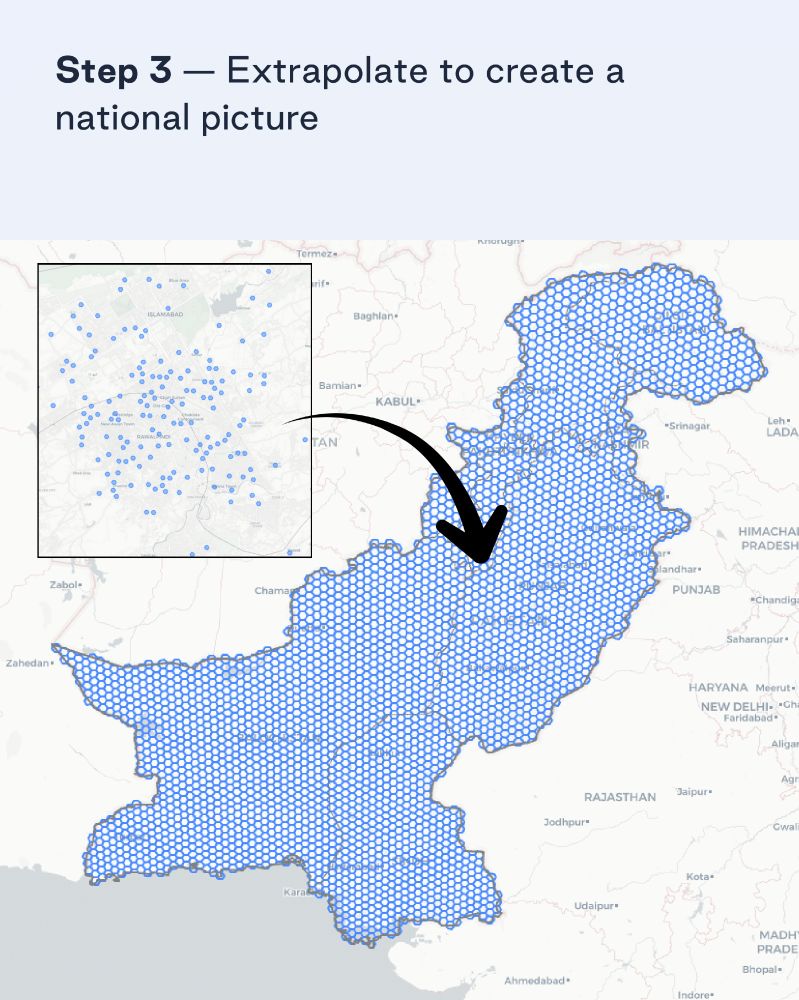
October 28, 2025 at 9:10 AM
3️⃣ We then used building and land-cover data to link solar patterns to building size and agricultural land.
These relationships let us extrapolate the amount of solar found in our image samples to a total capacity for across Pakistan — from city rooftops to rural fields
These relationships let us extrapolate the amount of solar found in our image samples to a total capacity for across Pakistan — from city rooftops to rural fields
2️⃣ Using a mix of machine learning and manual checks, we identified and labelled every rooftop and ground-mounted installation visible in our set of sample images — which amounted to more than 27,000 solar sites.

October 28, 2025 at 9:10 AM
2️⃣ Using a mix of machine learning and manual checks, we identified and labelled every rooftop and ground-mounted installation visible in our set of sample images — which amounted to more than 27,000 solar sites.
1️⃣ We divided Pakistan into thousands of small hexagonal cells, then selected around 1,000 representative locations.
Each one was covered by highly-detailed satellite images that can capture features as small as 30 centimetres across, covering both urban and rural areas.
Each one was covered by highly-detailed satellite images that can capture features as small as 30 centimetres across, covering both urban and rural areas.

October 28, 2025 at 9:10 AM
1️⃣ We divided Pakistan into thousands of small hexagonal cells, then selected around 1,000 representative locations.
Each one was covered by highly-detailed satellite images that can capture features as small as 30 centimetres across, covering both urban and rural areas.
Each one was covered by highly-detailed satellite images that can capture features as small as 30 centimetres across, covering both urban and rural areas.
📈 Pakistan has emerged as one of the world’s fastest-growing solar markets, but comprehensive data on actual installations remains limited.
But tracking small-scale solar across an entire country isn’t easy.
TransitionZero needed a faster, scalable way to see how solar is really spreading...
But tracking small-scale solar across an entire country isn’t easy.
TransitionZero needed a faster, scalable way to see how solar is really spreading...
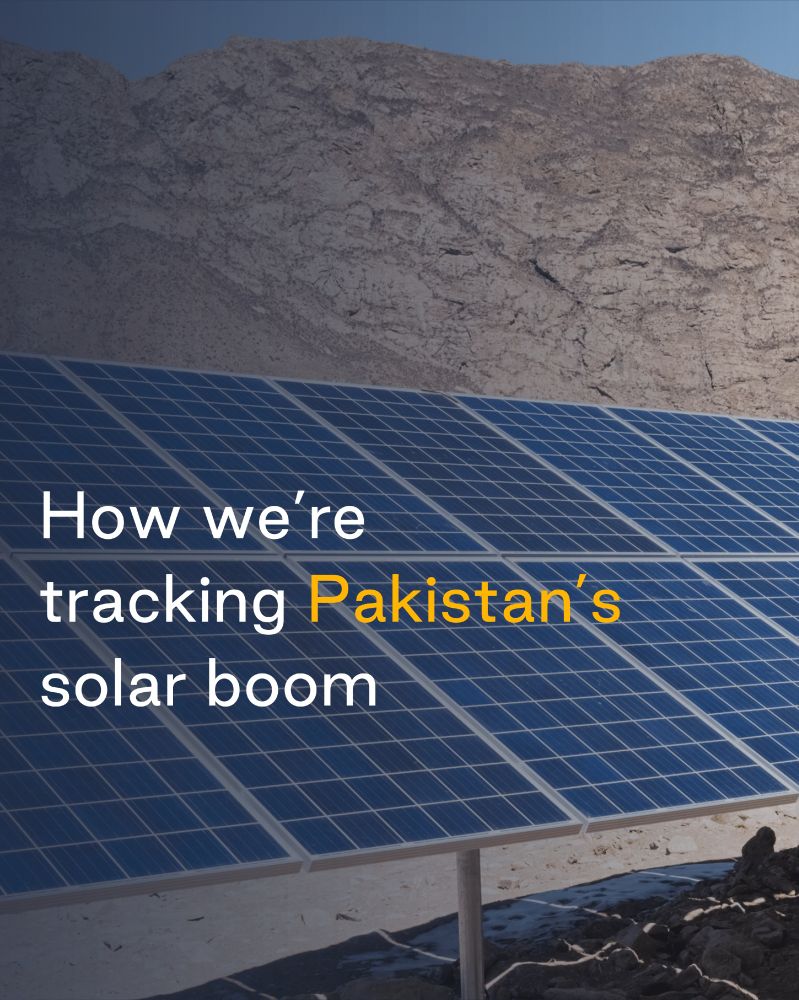
October 28, 2025 at 9:10 AM
📈 Pakistan has emerged as one of the world’s fastest-growing solar markets, but comprehensive data on actual installations remains limited.
But tracking small-scale solar across an entire country isn’t easy.
TransitionZero needed a faster, scalable way to see how solar is really spreading...
But tracking small-scale solar across an entire country isn’t easy.
TransitionZero needed a faster, scalable way to see how solar is really spreading...
⚡ We’re partnering with Google.org to make clean energy planning faster, smarter, and more accessible across Asia.
Together, we’re building the tools and capacity needed to accelerate the transition to affordable, reliable, and sustainable power.
Read the announcement here 👉 lnkd.in/ejW87Bs3
Together, we’re building the tools and capacity needed to accelerate the transition to affordable, reliable, and sustainable power.
Read the announcement here 👉 lnkd.in/ejW87Bs3

October 27, 2025 at 8:57 AM
⚡ We’re partnering with Google.org to make clean energy planning faster, smarter, and more accessible across Asia.
Together, we’re building the tools and capacity needed to accelerate the transition to affordable, reliable, and sustainable power.
Read the announcement here 👉 lnkd.in/ejW87Bs3
Together, we’re building the tools and capacity needed to accelerate the transition to affordable, reliable, and sustainable power.
Read the announcement here 👉 lnkd.in/ejW87Bs3
TransitionZero is proud to partner with Green Grids Initiative to accelerate the delivery of grid infrastructure that enables countries to meet their climate commitments.
Read all the details here 👉🏻 www.transitionzero.org/press/green-...
Read all the details here 👉🏻 www.transitionzero.org/press/green-...

October 21, 2025 at 2:19 PM
TransitionZero is proud to partner with Green Grids Initiative to accelerate the delivery of grid infrastructure that enables countries to meet their climate commitments.
Read all the details here 👉🏻 www.transitionzero.org/press/green-...
Read all the details here 👉🏻 www.transitionzero.org/press/green-...
👉 Download the full Modelling 24/7 Carbon-Free Energy in Taiwan report here → transitionzero.org/cfe
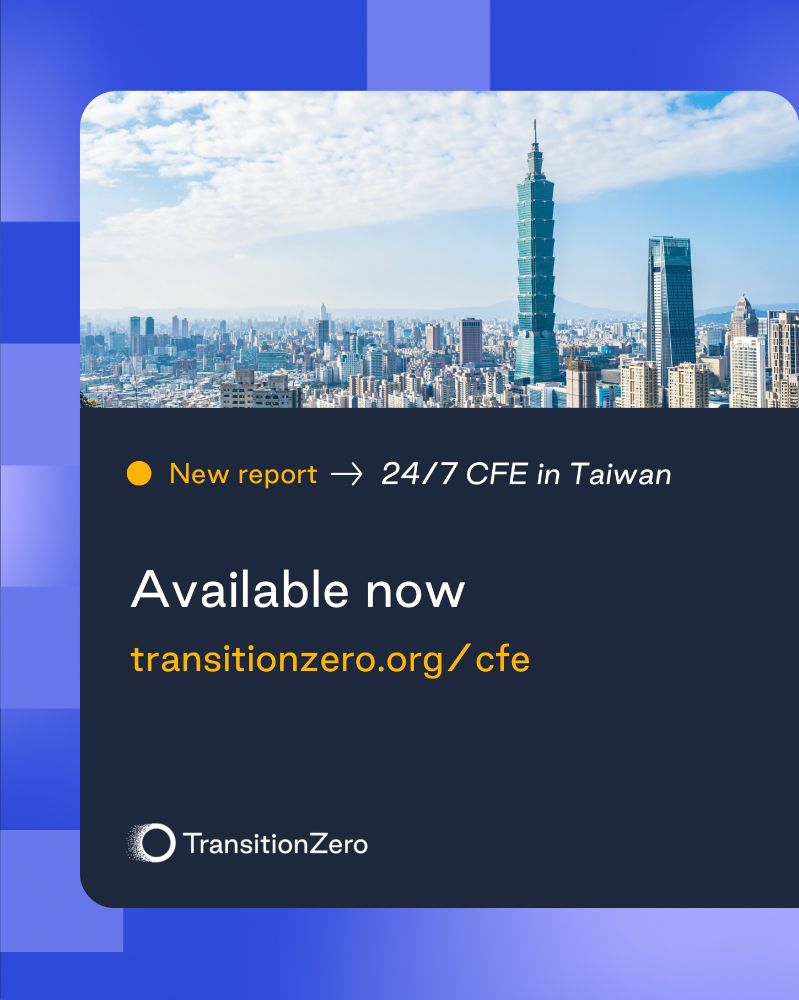
October 21, 2025 at 9:00 AM
👉 Download the full Modelling 24/7 Carbon-Free Energy in Taiwan report here → transitionzero.org/cfe
Reaching 80% CFE would also result in deep emissions cuts for the Taiwanese power system — 5MtCO2e per year, while requiring less overall capacity than annual matching, thanks to its reliance on geothermal for firm, clean supply.

October 21, 2025 at 9:00 AM
Reaching 80% CFE would also result in deep emissions cuts for the Taiwanese power system — 5MtCO2e per year, while requiring less overall capacity than annual matching, thanks to its reliance on geothermal for firm, clean supply.
The results are clear: if 5% of Taiwan’s grid electricity demand adopted 80% CFE, a least-cost approach that prioritises maximising cheaper onshore wind, solar and geothermal before turning to more expensive technologies, it would translate into system-wide savings of roughly US$1 billion per year.

October 21, 2025 at 9:00 AM
The results are clear: if 5% of Taiwan’s grid electricity demand adopted 80% CFE, a least-cost approach that prioritises maximising cheaper onshore wind, solar and geothermal before turning to more expensive technologies, it would translate into system-wide savings of roughly US$1 billion per year.
To find out, we developed a 1-node model of Taiwan’s 2030 power system using the open-source Python for Power System Analysis (PyPSA) package, with hourly resolution.
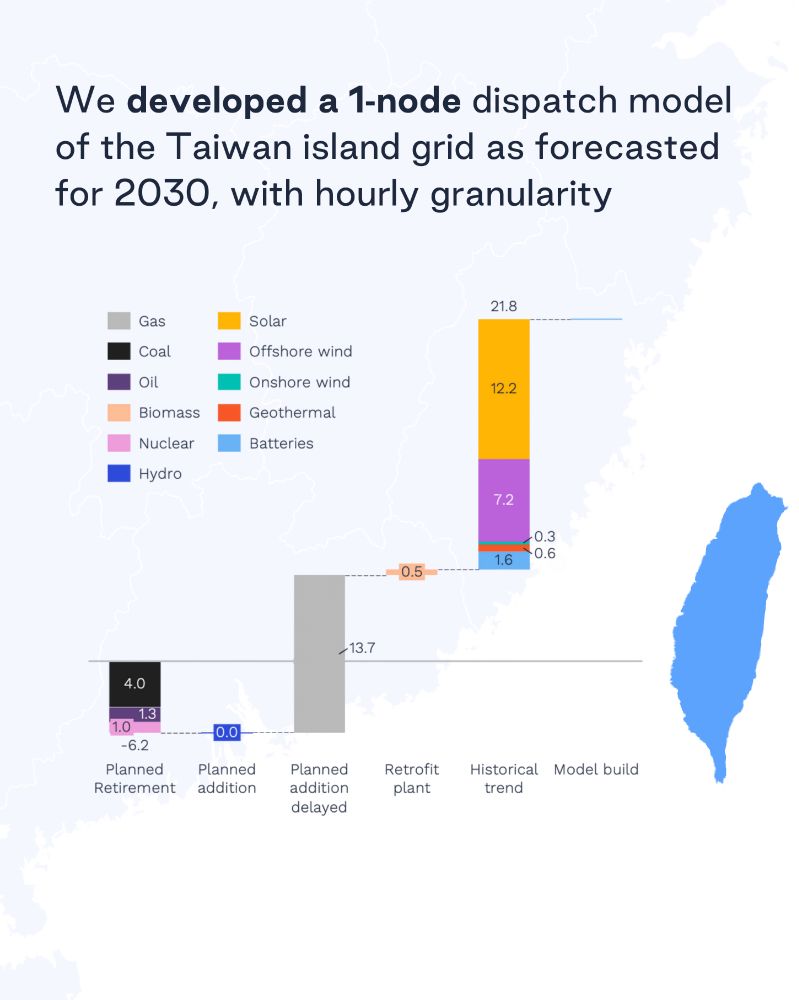
October 21, 2025 at 9:00 AM
To find out, we developed a 1-node model of Taiwan’s 2030 power system using the open-source Python for Power System Analysis (PyPSA) package, with hourly resolution.
Using a detailed, open-source model, we examined how 24/7 carbon-free energy could affect grid planners and corporate buyers.
Specifically, what would it mean if 5% of commercial and industrial demand was met with 24/7 CFE by 2030?
Specifically, what would it mean if 5% of commercial and industrial demand was met with 24/7 CFE by 2030?

October 21, 2025 at 9:00 AM
Using a detailed, open-source model, we examined how 24/7 carbon-free energy could affect grid planners and corporate buyers.
Specifically, what would it mean if 5% of commercial and industrial demand was met with 24/7 CFE by 2030?
Specifically, what would it mean if 5% of commercial and industrial demand was met with 24/7 CFE by 2030?
Our analysis shows strong benefits for commercial and industrial Taiwanese consumers to move toward hourly-matched 24/7 carbon-free energy (CFE) can support Taiwan’s decarbonisation goals.

October 21, 2025 at 9:00 AM
Our analysis shows strong benefits for commercial and industrial Taiwanese consumers to move toward hourly-matched 24/7 carbon-free energy (CFE) can support Taiwan’s decarbonisation goals.
🇹🇼 In 2024, the Taiwanese government raised its 2030 emissions reduction target from 24% to 28% below 2005 levels.
The country faces both opportunities and obstacles in shifting to a grid powered by low-cost, variable renewable energy.
The country faces both opportunities and obstacles in shifting to a grid powered by low-cost, variable renewable energy.

October 21, 2025 at 9:00 AM
🇹🇼 In 2024, the Taiwanese government raised its 2030 emissions reduction target from 24% to 28% below 2005 levels.
The country faces both opportunities and obstacles in shifting to a grid powered by low-cost, variable renewable energy.
The country faces both opportunities and obstacles in shifting to a grid powered by low-cost, variable renewable energy.
🇹🇼 How could a subset of commercial and industrial consumers using 24/7 carbon free energy help Taiwan achieve their emissions reduction goals?
Our report will be released tomorrow.
🔎 Meanwhile, now is a great time to read our explainer on 24/7 CFE 👉 www.transitionzero.org/insights/wha...
Our report will be released tomorrow.
🔎 Meanwhile, now is a great time to read our explainer on 24/7 CFE 👉 www.transitionzero.org/insights/wha...

October 20, 2025 at 7:41 AM
🇹🇼 How could a subset of commercial and industrial consumers using 24/7 carbon free energy help Taiwan achieve their emissions reduction goals?
Our report will be released tomorrow.
🔎 Meanwhile, now is a great time to read our explainer on 24/7 CFE 👉 www.transitionzero.org/insights/wha...
Our report will be released tomorrow.
🔎 Meanwhile, now is a great time to read our explainer on 24/7 CFE 👉 www.transitionzero.org/insights/wha...
👉 Download the full Modelling 24/7 Carbon-Free Energy in Malaysia report here → transitionzero.org/cfe

October 16, 2025 at 6:30 AM
👉 Download the full Modelling 24/7 Carbon-Free Energy in Malaysia report here → transitionzero.org/cfe
Overall, 24/7 CFE by 2030 can be delivered at a lower system cost than annual matching, and these savings grow as CFE targets rise, reaching, ranging from US$560 to 710 million in avoided fuel cost.

October 16, 2025 at 6:30 AM
Overall, 24/7 CFE by 2030 can be delivered at a lower system cost than annual matching, and these savings grow as CFE targets rise, reaching, ranging from US$560 to 710 million in avoided fuel cost.
Results show that optimal hourly matching for C&I consumers is high: 80% CFE in Peninsular Malaysia and 90% CFE in Sarawak. In comparison to hourly matching, net system costs are US$10 million at 80% CFE in Peninsular Malaysia and US$5 million lower at 90% CFE in Sarawak.

October 16, 2025 at 6:30 AM
Results show that optimal hourly matching for C&I consumers is high: 80% CFE in Peninsular Malaysia and 90% CFE in Sarawak. In comparison to hourly matching, net system costs are US$10 million at 80% CFE in Peninsular Malaysia and US$5 million lower at 90% CFE in Sarawak.
Our model includes three domestic nodes — Peninsular Malaysia, Sarawak, and Sabah — and three international interconnectors with Singapore, Thailand, and Indonesia.
Peninsular Malaysia and Sarawak are expected to see significant CFE demand from large C&I consumers.
Peninsular Malaysia and Sarawak are expected to see significant CFE demand from large C&I consumers.

October 16, 2025 at 6:30 AM
Our model includes three domestic nodes — Peninsular Malaysia, Sarawak, and Sabah — and three international interconnectors with Singapore, Thailand, and Indonesia.
Peninsular Malaysia and Sarawak are expected to see significant CFE demand from large C&I consumers.
Peninsular Malaysia and Sarawak are expected to see significant CFE demand from large C&I consumers.
Using a detailed, open-source model, we examined how 24/7 carbon-free energy could affect grid planners and corporate buyers. Specifically, what would it mean if 5% of commercial and industrial demand was met with 24/7 CFE by 2030?

October 16, 2025 at 6:30 AM
Using a detailed, open-source model, we examined how 24/7 carbon-free energy could affect grid planners and corporate buyers. Specifically, what would it mean if 5% of commercial and industrial demand was met with 24/7 CFE by 2030?
Our analysis shows strong benefits for commercial and industrial Malaysian consumers to move away from annual matching toward hourly-matched 24/7 carbon-free energy (CFE) can support Malaysia’s digitalisation and decarbonisation goals.

October 16, 2025 at 6:30 AM
Our analysis shows strong benefits for commercial and industrial Malaysian consumers to move away from annual matching toward hourly-matched 24/7 carbon-free energy (CFE) can support Malaysia’s digitalisation and decarbonisation goals.

